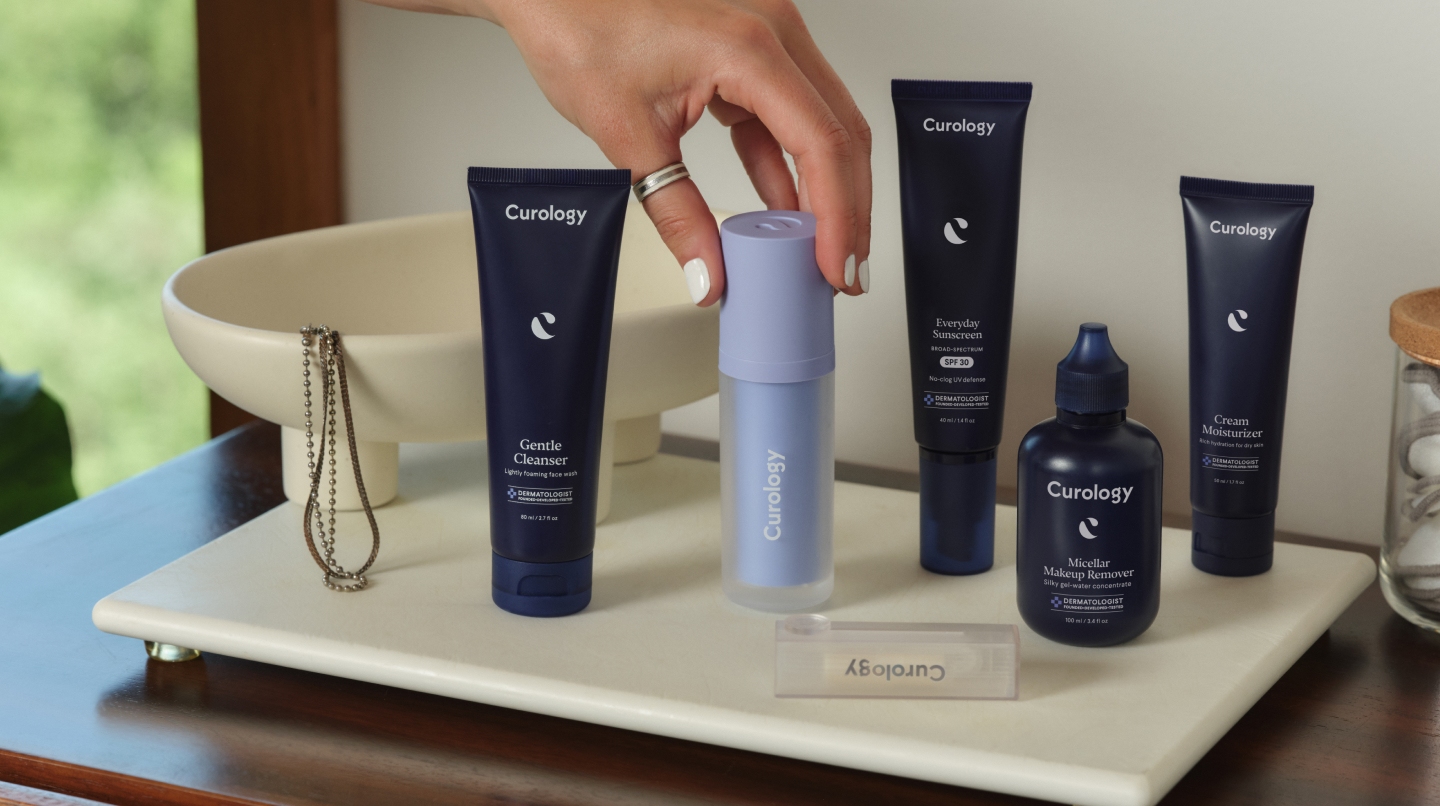How it works:
Share your skin goals and snap selfies
Your dermatology provider prescribes your formula
Apply nightly for happy, healthy skin
How it works:
How it works:
Share your skin goals and snap selfies
Your dermatology provider prescribes your formula
Apply nightly for happy, healthy skin
How it works:
Sunscreen 101: How much should you apply to your face?
Slathering on the right amount of SPF is key to keeping your skin safe from the sun’s UV rays.



Nothing beats a beautiful sun-filled day. But basking in those warm rays can cause some serious sun damage to your skin, even if you spend most of your time indoors or have some natural sun protection, thanks to your skin tone. That’s why wearing sunscreen should be part of your daily skincare ritual.*
Here we’ll talk about how much sunscreen you should apply to your face, how to measure sunscreen, and some tips for applying the right amount. Wearing sunscreen is important—but it’s essential to know how to wear sunscreen the right way, to ensure that you protect your skin from harmful UV rays the best you can.
How to measure sunscreen?
Most experts agree that you should apply about one ounce of sunscreen, or enough to fill a full shot glass, to your body.¹ Although there is no universal standard for sunscreen application, this equates to approximately two milligrams per square centimeter of skin.²
The rule of nines divides the body into 11 areas, including head, neck, and face; left arm; right arm; upper back; lower back; upper front torso; lower front torso; left upper leg and thigh; right upper leg and thigh; left lower leg and foot; and right lower leg and foot.
So, how much should you apply to each area? It’s roughly the amount to fully cover two fingers or a nickel-sized dollop. Learn more about the two-finger rule here!
It’s a bit trickier when using sunscreen sticks or spray sunscreens. With stick sunscreens, use at least a few passes back and forth and then rub that in for even coverage. For sprays, apply evenly until your skin glistens. If you’re using spray sunscreen for your face, spray the sunscreen into the palms of your hands and use your hands to apply it to your face. This isn’t an exact science though, so this can vary from person to person.
To achieve the level of UV protection indicated on the bottle, regardless of whether you’re using a mineral or chemical formula, where you live, or what time of the year it might be, you always need to apply the correct amount. Following the directions on the package, in addition to the tips outlined above, is a great place to start!
How much sunscreen should you apply to your face?
Sunscreen is your skin’s best defense against premature aging. Because many of us don’t cover our faces with clothing or wear wide-brimmed hats every time we go outside, we need to be diligent about using sunscreen. So, exactly how much sunscreen should you apply to your face? The easiest method—and one that is always available—is the two-finger rule. Squeeze a line of sunscreen from the base to the tip of your index and middle fingers and apply to your face and neck.
How to apply sunscreen
Sunscreen works by reflecting away the sun’s rays in the case of mineral sunscreens or, in the case of chemical sunscreens, by absorbing UV light and causing it to undergo a chemical reaction that prevents it from damaging the skin.³ Although there is no uniform agreement regarding the order of application, it typically makes the most sense to apply sunscreen as the last step in your skincare routine.
It’s best to apply skincare products to a clean face. After washing your face, layer your products as recommended, allowing enough time for each product to absorb into the skin. Don’t be tempted to skip a step or combine your sunscreen with your moisturizer. Each product is formulated to work on its own, and if you mix products, you can change their effectiveness.
Here are some tips to keep your skin safe and protected from the sun:
Apply sunscreen about 15 minutes before going into the sun to give it enough time to form a protective barrier (for an exact time, follow the directions on the bottle).
Don’t forget your hairline, behind your ears, your eyelids, and under your nose.
Put on more than you think you need. Most people use less than what’s recommended, so don’t be afraid of overdoing it.
Use makeup products that contain SPF for extra protection.
Consider mineral-based sunscreen if you have acne-prone or sensitive skin.
Use a sunscreen that goes on white and dries clear so you can see that you’ve covered your entire face and didn’t leave any unprotected areas.
How often should you reapply sunscreen?
Reapplication is very important and should be part of your routine. How long you’re outside, what you’re wearing, and what you’re doing all play a role in when and how you reapply your sunscreen. As a general rule, reapply every two hours, after you swim or sweat, or after you towel off.⁴ Be sure to reapply to the surface area of skin that’s exposed to the sun and under your clothes, depending on how well they protect you from UV rays and how long you’re outdoors.
Here are a few more tips to boost your sun protection:
Wear protective clothing to provide an extra level of protection. The next best thing to UPF (Ultraviolet Protection Factor) clothing are items with a high thread count.
Use a large-brimmed hat to keep your face shaded.
Sit in the shade whenever possible to minimize how much sun you’re receiving.
Use water-resistant sunscreen that lasts 40-80 minutes.
What SPF should your sunscreen have?
SPF stands for “sun protection factor”. According to the FDA, this number measures of how much UV radiation is required to produce sunburn on skin protected with sunscreen compared to the amount of UV radiation required to sunburn unprotected skin. As the SPF value increases, sunburn protection increases.⁵ How much SPF protection you need for your face daily depends on what you do. Most dermatologists recommend broad-spectrum sunscreen with SPF 30+ and diligent application to protect against the sun.⁶ Broad-spectrum sunscreen protects against UVA rays and UVB rays.⁷
There are differences between the numbers. A higher SPF provides slightly more protection. SPF 30 filters 97% of the sun’s rays, and a higher number SPFs block slightly more, however, no sunscreen can block 100% of the sun’s UVB rays.
Does Curology sell sunscreen?
The sunscreen by Curology is a grease-free, 100% mineral-based SPF 30 sunscreen that won’t leave a white cast on your skin or clog your pores. The sunscreen uses zinc oxide as its active ingredient, which helps prevent potentially damaging ultraviolet radiation from getting to the skin. It’s designed by dermatologists for acne-prone skin (but it works well on all skin types) and created to work with all our Curology products.
Get your personalized skincare routine with Curology
Get your personalized skincare routine with Curology


Like all our products, the sunscreen is acne-friendly, but it’s currently available only through a Curology subscription. For new members, sign up for a 30-day trial and add the sunscreen to your order for free (+$4.95 for shipping and handling). Existing members can add sunscreen to their plan for $14 (plus taxes where applicable).
We’ve covered a lot about how much sunscreen to apply. Here are some final FAQs to bust sunscreen myths, so you get the most protection from your sunscreen.
FAQs
Not all sunscreens are formulated to work perfectly with the skin on your face. Some may lead to dry skin while others may lead to a breakout. A good daily face sunscreen is formulated with ingredients that work with your skin type. Here are some more tips for choosing the best sunscreen for combination skin.
Most people don’t think they’re getting sun when working inside, but more than 50% of UVA light penetrates glass.⁸ Wearing sunscreen—and reapplying every two hours—is often necessary even when you’re indoors. So, yes, you should use sunscreen on your face daily regardless of whether you’re indoors or outdoors.
P.S. We did the homework so you don’t have to:
American Academy of Dermatology Association. Sunscreen FAQS. (n.d.).
Taylor S, et al. Simple Dosage Guide for Suncreams Will Help Users. JBM. (June 2002).
Torborg, L. Mayo Clinic Q and A: Sunscreen Best Practices. (2016, June 21).
Diffey, BL. When Should Sunscreen Be Reapplied?. Journal of Academy of Dermatology. (2001, December 1.)
U.S. Food and Drug Administration. Sun Protection Factor (SPF). (2017).
American Academy of Dermatology Association. Sunscreen FAQS. Ibid.
American Academy of DermatologyAssociation. Sunscreen FAQS. Ibid.
Venosa A. 5 Sneaky Ways You’re Being Exposed to the Sun’s UV Rays. Sun & Skin News. (2017, May 10).
*Sunscreen cannot prevent all harm from UV rays.
* Subject to consultation. Subscription is required. Results may vary.

Curology Team

Meredith Hartle, DO
Related Articles
Finasteride vs. minoxidil: Which hair loss treatment is right for you?How to remove makeup without makeup remover wipesThe complete guide to face cleansers for every skin typeSkincare tips for dry skin, according to dermatology providersDoes dermaplaning cause acne? Experts explainPopular Articles
Ask Curology: Is my cold breaking me out?Slugging: The dermatologist-approved skincare hack going viral on TikTokTretinoin vs retinol: What’s the difference?How to create a self-care routine that actually sticksYour 2023 skincare horoscopeTry prescription skincare
Get routine essentials

Good skin days ahead
- Breakouts
- Redness
- Fine lines
- Dark spots
- Hair thinning